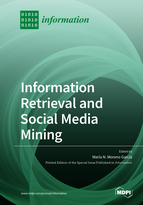Information Retrieval and Social Media Mining
A special issue of Information (ISSN 2078-2489). This special issue belongs to the section "Artificial Intelligence".
Deadline for manuscript submissions: closed (30 September 2020) | Viewed by 30799
Special Issue Editor
Interests: data mining; web mining; machine learning; deep learning; recommender system; decision support in medicine
Special Issues, Collections and Topics in MDPI journals
Special Issue Information
Dear Colleagues,
The MDPI journal Information is inviting submissions for a Special Issue on “Information Retrieval and Social Media Mining”.
The increasing interest of citizens for websites, social networks, streaming services, and other online media has led to the web becoming an indispensable instrument in daily life for business activities, learning, entertainment, communication, etc. Internet users can now share and access a nearly unlimited amount of information. This opens up great opportunities to exploit this valuable information by transforming it into useful knowledge through appropriate techniques. In this context, data mining methods arise as efficient tools to help users in the recovery of suitable online information, products, or services as well as to explore a wide range social media aspects regarding user behavior, communities, networks structures, information diffusion, and many more.
This Special Issue aims at providing a forum for the presentation and discussion of the latest advances concerning the web and social media mining.
Topics of interest may include, but are not limited to, the following:
- Web mining—content, structure, and usage mining;
- User profiling and personalization;
- Recommender systems;
- Sentiment analysis and opinion mining;
- Social influence analysis;
- Detection and analysis of social communities;
- Information diffusion in social media.
Dr. María N. Moreno García
Guest Editor
Manuscript Submission Information
Manuscripts should be submitted online at www.mdpi.com by registering and logging in to this website. Once you are registered, click here to go to the submission form. Manuscripts can be submitted until the deadline. All submissions that pass pre-check are peer-reviewed. Accepted papers will be published continuously in the journal (as soon as accepted) and will be listed together on the special issue website. Research articles, review articles as well as short communications are invited. For planned papers, a title and short abstract (about 100 words) can be sent to the Editorial Office for announcement on this website.
Submitted manuscripts should not have been published previously, nor be under consideration for publication elsewhere (except conference proceedings papers). All manuscripts are thoroughly refereed through a single-blind peer-review process. A guide for authors and other relevant information for submission of manuscripts is available on the Instructions for Authors page. Information is an international peer-reviewed open access monthly journal published by MDPI.
Please visit the Instructions for Authors page before submitting a manuscript. The Article Processing Charge (APC) for publication in this open access journal is 1600 CHF (Swiss Francs). Submitted papers should be well formatted and use good English. Authors may use MDPI's English editing service prior to publication or during author revisions.
Keywords
- social media mining
- personalization
- recommender systems
- sentiment analysis






